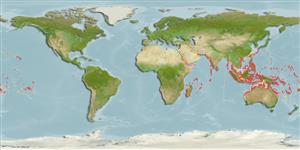分類 / Names
俗名 | 同種異名 | Catalog of Fishes(屬, 種) | ITIS | CoL | WoRMS | Cloffa
Teleostei >
Eupercaria/misc (Various families in series Eupercaria)
鱸形目 (Various families in series Eupercaria) >
Labridae (Wrasses)
隆頭魚科 (Wrasses) > Cheilininae
Etymology: Cheilinus: Greek, cheilos = lip (Ref. 45335).
More on author: Lacepède.
Environment: milieu / climate zone / depth range / distribution range
生態學
海洋; 半鹹淡水 礁區魚類; 深度上下限 1 - 30 m (Ref. 1602). 熱帶; 30°N - 28°S, 32°E - 139°W
Indo-Pacific: East Africa to the Tuamoto and Austral islands, north to the Ryukyu Islands, south to New Caledonia.
印度-太平洋: 東非到 Tuamoto 與奧斯垂群島, 北至琉球群島, 南至新加勒多尼亞。
Length at first maturity / 大小 / 重量 / 年齡
Maturity: Lm ?, range 26 - ? cm
Max length : 45.0 cm TL 雄魚/尚未辨別雌雄; (Ref. 9710)
背棘 (總數) : 9; 背的軟條 (總數) : 10; 臀棘: 3; 臀鰭軟條: 8. This species is distinguished by the following characters: body moderately deep, its depth 2.3-2.6 times in standard length; dorsal profile of head convex; anterior tip of snout forming an acute angle; jaws prominent, 2 strong canines situated anteriorly in each jaw; no enlarged tooth present of rear of upper jaw. D IX,10, the spines and anterior soft rays of similar length; A III,8; pectoral fins with ii unbranched and 10 branched rays; pelvic fins long, reaching anus in small fish, well beyond in adults; centre of caudal fin rounded in adults, with the upper and lower rays forming elongate lobes giving the fin a trilobed appearance; lateral line interrupted below posterior portion of dorsal-fin base, with a total of 22-23 pored scales; scales reaching well onto bases of dorsal and anal fins; scales in front of dorsal fin extending forward to above centre of eye; cheek and opercle scaly; lower jaw without scales. Colour of the body variably pigmented from green to brown with mottled purple and red markings; 4 vertical dark bars on body that are often indistinct on large individuals; head with numerous small red spots; red lines radiating from anterior and posterior of eye; scales on sides each with a vertical, slightly curved red line; dorsal, anal, and pectoral fins yellow or green with distal red streaks; caudal fin green with a red posterior margin; juveniles with 3-4 dark spots midlaterally on sides and more prominent dark bars. This species capable of rapid colour changes (Ref. 9823).
橄欖色的在每個身體鱗片上具有一個垂直的紅色線; 在頭部與胸上的小的紅色斑點與不規則的線; 紅色的線前面地從眼放射.(參考文獻 4392) 這種的大的成魚有三葉的尾鰭。
Adults inhabit lagoon and seaward reefs at depths of 1 to over 30 m, and relatively common along shallow reef margins with good coral cover (Ref. 9710). Usually solitary (Ref. 5213). Feed mainly on shelled benthic invertebrates such as mollusks and crustaceans, but occasionally take fishes (Ref. 1602). Oviparous, distinct pairing during breeding (Ref. 205). Difficult to approach (Ref. 9710). Juveniles secretive on algae reefs and usually around stinging hydrozoans (Ref. 48636).
棲息於潟湖與臨海礁石深度 1 到超過 30 公尺, 與相當普遍的沿著水淺的礁區邊緣珊瑚覆蓋完整的地方.(參考文獻 9710) 通常獨居性的.(參考文獻 5213) 主要吃有殼的底棲無脊椎動物例如軟體動物與甲殼動物, 但是偶而吃魚.(參考文獻 1602) 困難的接近.(參考文獻 9710) 稚魚躲躲藏藏的在藻礁上與通常在刺水息蟲的周圍.(參考文獻 48636)
Life cycle and mating behavior
Maturities | 繁殖 | Spawnings | Egg(s) | Fecundities | 仔魚
Oviparous, distinct pairing during breeding (Ref. 205).印度-太平洋: 東非到 Tuamoto 與奧斯垂群島, 北至琉球群島, 南至新加勒多尼亞。
Westneat, M.W., 2001. Labridae. Wrasses, hogfishes, razorfishes, corises, tuskfishes. p. 3381-3467. In K.E. Carpenter and V. Niem (eds.) FAO species identification guide for fishery purposes. The living marine resources of the Western Central Pacific. Vol. 6. Bony fishes part 4 (Labridae to Latimeriidae), estuarine crocodiles. FAO, Rome. (Ref. 9823)
IUCN 瀕危狀態 (Ref. 130435)
無危 (LC) ; Date assessed: 04 February 2009
人類使用
漁業: 低經濟; 水族館: 商業性
工具
特別的報告
下載 XML
網路資源
Estimates based on models
Preferred temperature (Ref.
123201): 25.2 - 29.3, mean 28.4 °C (based on 3095 cells).
Phylogenetic diversity index (Ref.
82804): PD
50 = 0.5078 [Uniqueness, from 0.5 = low to 2.0 = high].
Bayesian length-weight: a=0.02239 (0.01578 - 0.03176), b=2.95 (2.85 - 3.05), in cm total length, based on LWR estimates for this species (Ref.
93245).
營養階層 (Ref.
69278): 3.9 ±0.2 se; based on diet studies.
回復力 (Ref.
120179): 中等的, 族群倍增時間最少 1.4 - 4.4年 (Preliminary K or Fecundity.).
Fishing Vulnerability (Ref.
59153): Low to moderate vulnerability (35 of 100).
Nutrients (Ref.
124155): Calcium = 35.7 [18.4, 61.7] mg/100g; Iron = 0.581 [0.245, 1.126] mg/100g; Protein = 17.8 [13.6, 21.1] %; Omega3 = 0.0833 [, ] g/100g; Selenium = 30.6 [15.1, 62.7] μg/100g; VitaminA = 137 [21, 863] μg/100g; Zinc = 2.5 [1.4, 3.5] mg/100g (wet weight); based on
nutrient studies.
